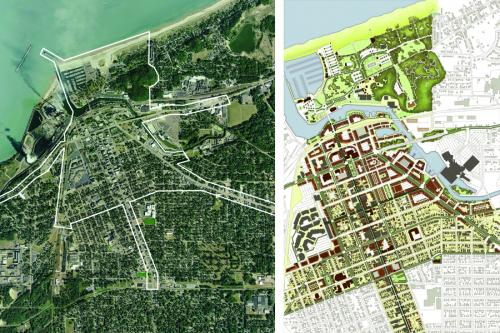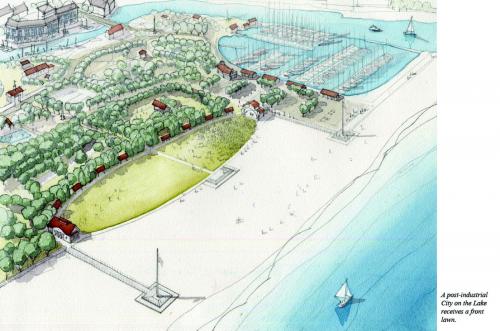
The North End Plan
Location: Michigan City, Indiana, USA. town center redevelopment
Founded in 1832, Michigan City is a relatively typical Midwestern "rust belt" town with a total population of about 33,000. Located on Lake Michigan, much of the city center is defined by a struggling commercial core, abandoned industrial properties and vacant land. Urban renewal projects in the 1970's cleared and suburbanized the historic mixed-use area. However, despite the centers depressed condition an annual average of six million people visit the city's center's three isolated attractions: the lakefront park with pristine beaches, the casino barge, and a 1980's outlet shopping mall.
Twenty-six fifth-year architecture students at Andrews University engaged local citizens in an eight-day public charrette in order to identify local growth patterns, places worth preserving, available resources, and desirable yet feasible growth strategies for a revitalization plan. The results were a set of goals for possible future redevelopment.
The development includes mixed-use and pedestrian-friendly environments to bring a substantial residential population within the city. Improved access to the waterfront can help take advantage of tourism and can serve as an amenity for existing and future residents throughout the downtown area. By capitalizing on the existing outlet shopping center and casino, new developments can engage these existing entities. Transit-Oriented development is also used as a strategy in this plan. The South Shore Line which travels between South Bend, Indiana and the Chicago Loop can be harnessed for revitalization and economic development purposes.
The proposed project also seeks to provide a wide range of meaningful public places, and pays particular attention to the reoganization of the civic center, which was the heart of the urban renewal effort. They also hope to incorporate architecture that builds on local traditions, being that Michigan City Residents are proud of their historic architecture and are eager to avoid the past mistakes of urban renewal and other modernist experiments.
Lessons learned: One of the greatest lessons learned for the students was the value of the public participatory process and learned that their skills at drawing and their ability to synthesize a range of problems into formal solutions on site for public review was invaluable.
Transect Zone(s): T3 sub-urban, T4 general, T5 center.
Status: <Unknown>
Guiding Charter Principle(s): Principle 14, 19, 24, 25,
Project or Plan's Scale: Neighborhood
Features: Civic buildings & parks, Transit oriented development, Waterfront.
Land area (in acres): 670
Total built area (in sq. ft.):
Total project cost (in local currency):
Retail area (in sq. ft.):
Office area (in sq. ft.):
Industrial area (in sq. ft.):
Number of hotel units:
Number of residential units (include live/work):
Parks & green space (in acres):
Project team designers: Student Designers, The School of Architecture at Andrews University
Project team developers: The School of Architecture, Andrews University
Previous site status:
Starting/Ending date of construction/implementation: -





